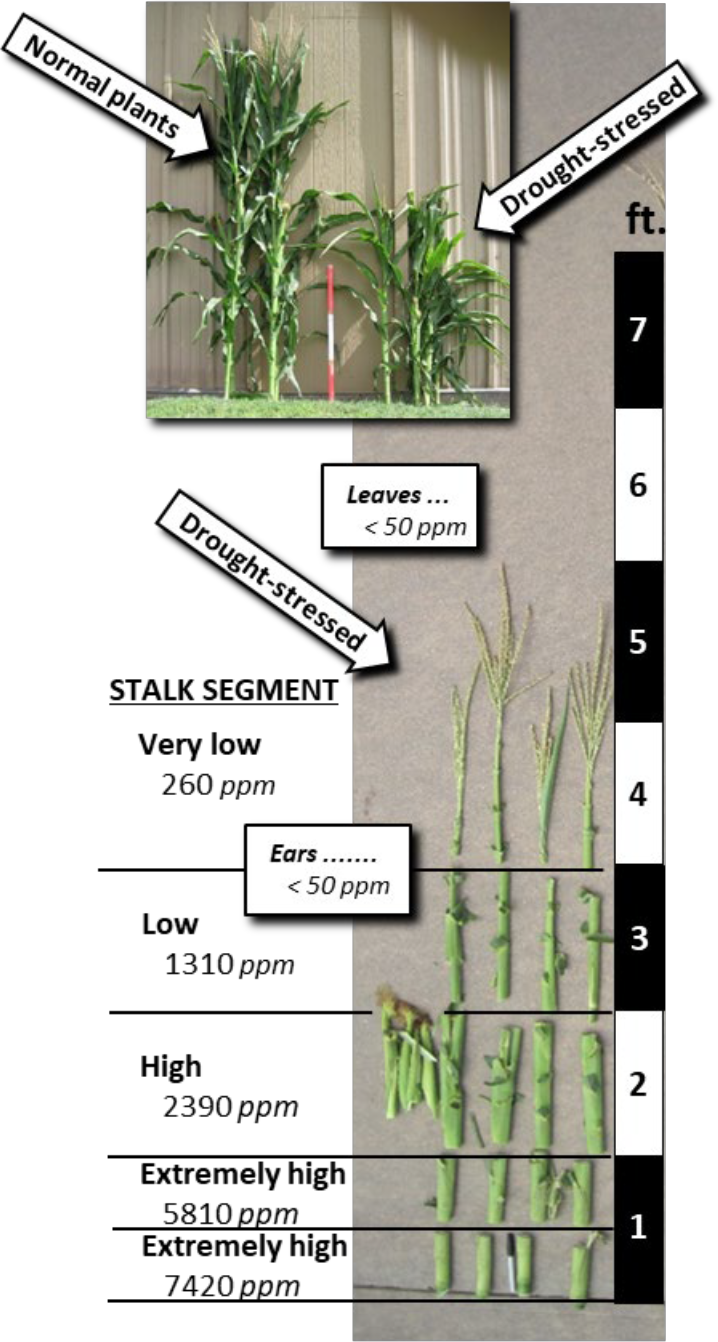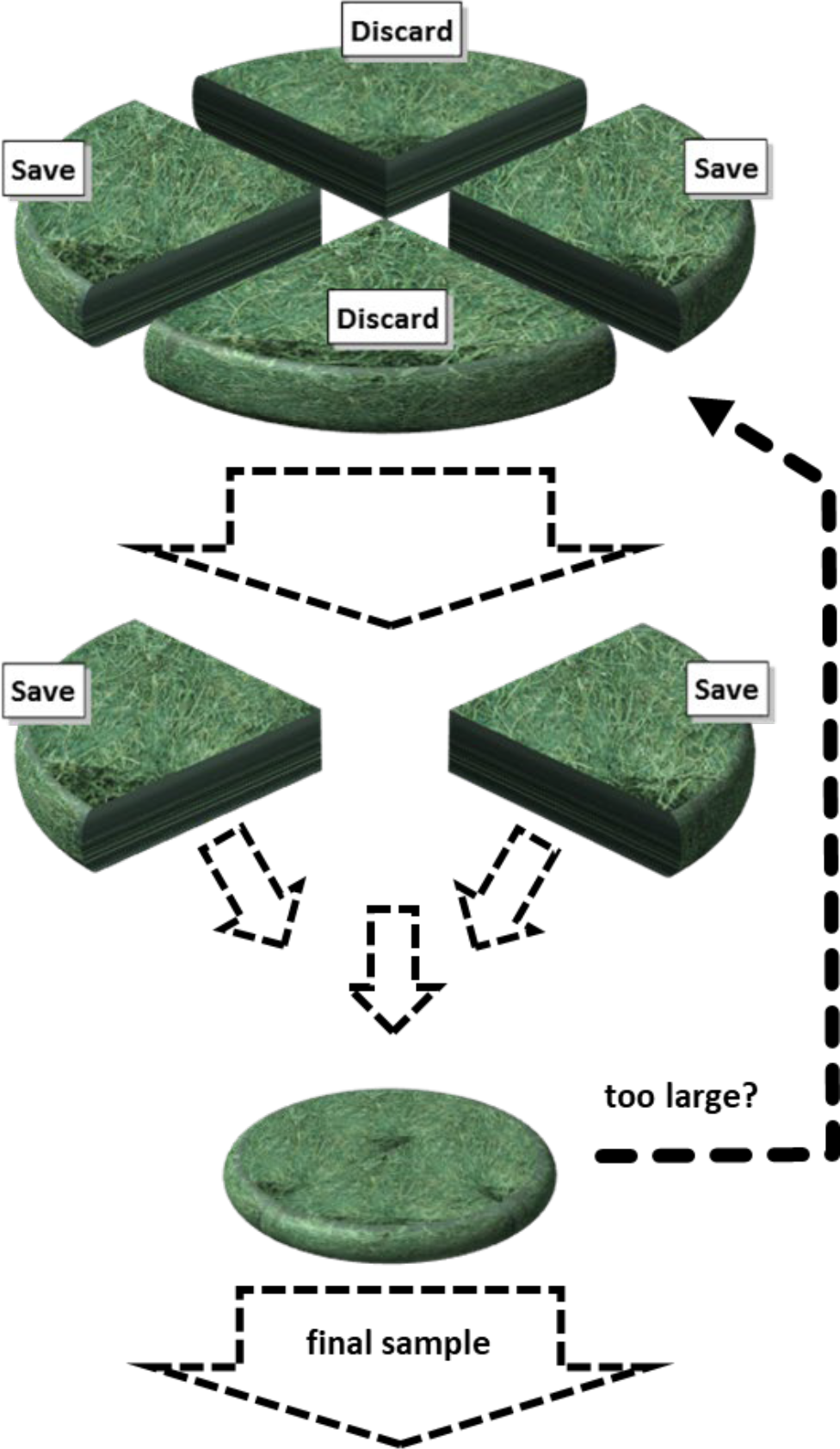⇦ Back to Crop Management Home
¶ Introduction
Green chop or direct grazing may be potential alternatives for salvaging drought-stressed corn, but both require careful management. “Green chop” refers to chopping a standing crop, then feeding it in fresh form without ensiling.
This Crop File provides some guidance for these two methods of drought-stressed corn harvest.
¶ A. General considerations
- Check pesticide labels
- Check preharvest intervals and restrictions.
¶ Check if preharvest intervals apply to dairy or beef cattle.
- Check insurance coverage
- Check with appropriate agent or adjuster for guidance to assure corn crop harvested as forage will qualify for coverage.
- Forage quality is variable.
- Variations in plant height, maturity, ear development, and grain fill affect nutrient levels.
- Barren stalks may have high nutrient levels.
- Protein and energy that normally would have been transferred to grain instead are stored in stalks and leaves.
- Nitrate toxicity concerns
- Predicting nitrate levels by growth stage, nitrogen fertilizer rate, or other factors is impossible.
- Nitrate accumulations generally highest in lower 12 to 18 inches of standing cornstalks (see Figure 1).
- Leaves, tassels, and upper stalk do not usually accumulate nitrates, even when drought stressed.
- Toxicity risk increases rapidly above 1000 to 1500 ppm NO3-N.
- Set cutter bar height above 12 to 15 inches.
- Helps avoid plant parts with highest nitrate accumulations.
¶ Figure 1. Nitrate-Nitrogen Levels and Nitrate Toxicity Ratings of Different Plant Parts

¶ B. Green Chop
- Feed immediately after harvest.
- Do not hold second feeding from morning to evening.
- Do not hold green-chop overnight.
- Delayed feeding enhances conversion of nitrate (NO3) to nitrite (NO2) by bacterial activity.
- Nitrite is 10 times as toxic as nitrate when fed to livestock.
- Don’t feed more than livestock will consume in two or three hours.
- Green chopped forage remaining in bunks or wagons can heat and spoil.
- Also encourages conversion of nitrate to nitrite.
- Recommend feeding green chop two to three times per day.
- Helps ensure that forage is cleaned up quickly and does not remain in bunks or feeders.
- Ensure adequate bunk space is available.
- Recommend about 36 inches of space per animal.
- Helps assure dominant animals do not overeat and animals lower in hierarchy receive their share.
- Supplement green-chopped forage with other feeds to meet daily nutrient requirements.
- Do not feed high urea supplements with high nitrate green-chop.
- Make low nitrate hay available before feeding green chop to help animals fill up.
- Helps dilute effect of individual plants with high nitrate levels.
- Provide source of high energy feed, like corn grain.
- Helps maintain healthy rumen environment, improves nitrate/nitrite detoxification processes.
- Condition animals by starting them on green chop slowly.
- Suggested program:
- Feed 5 pounds per head twice daily for first few days.
- Feed 10 pounds per head twice daily for few more days
- Increase feeding rate to 15 pounds after seven to 10 days.
- Suggested program:
¶ C. Grazing
- Limit field access to help manage grain and nitrate risks.
- Allowing free choice access to unharvested drought-damaged corn is risky.
- Requires fewer facilities, labor, or equipment.
- Do not turn hungry cattle into fields suspected of nitrate problems.
- Hungry animals may devour everything available.
- Consider feeding high quality hay to help fill animals before grazing.
- Make sure plenty of fresh water is readily available.
- Provide poloxalene (bloat blocks) as optional safety measure.
- Cattle graze selectively from corn fields.
- Mature animals tend to preferentially select corn ears.
- Excess grain consumption can lead to acidosis and foundering.
- In one research study, steers grazed leaves, tops, ears, and then stalks.
- In another research study, cows grazed ears, leaves, tops, then stalks, in that order.
- Do not force cattle to eat lower portion of stalk.
- Lower stalk typically has highest nitrate content.
- Use “strip grazing” strategy.
- Divide field into paddocks by cross fencing
- Allow cattle to graze for 2 to 3 days per paddock.
- Will help limit intake and reduce trampling
- Increases forage utilization, even if stalks are only available corn forage.
- May need to remove animals if it rains.
- May be flush of forage nitrates if significant rain follows extended dry period (see Table 1).
- Soil nitrates will be remobilized and taken up as plants recover and take up water.
- Suggest halt in grazing for 7 to 14 days after significant rain event.
- Suggested strategy: stepped up grazing
- Limit grazing for first six to eight days by increasing daily grazing time.
- Do not allow hungry animals to graze (item #2 above).
- Day 1: graze high nitrate forage for two hours.
- Days 2 to 6: increase grazing time by two hours each day for six days.
- Day 7 and beyond: Release animals full time onto high nitrate forage, if there are no obvious problems.
- Stop grazing immediately if animal stress is observed.
- Suggested strategy: interrupted grazing
- Feed animals three to five times per day.
- Tends to disrupt grazing periods.
- Helps rumen-fill; slows consumption rate and total amount consumed.
¶ Table 1. Rainfall Effect on Nitrate Content of Forage Sorghum |
||||
| Before Rain |
Time after rain (fell on Sept. 15) |
|||
| --- | 24 hr. | 48 hr. | 7 days | |
| Plant part | --------------- ppm NO3-N --------------- | |||
| Leaves | 385 | n/a | n/a | 1015 |
| Top 1/3 | 645 | 735 | 875 | 1035 |
| Middle 1/3 | 680 | n/a | 1015 | 1465 |
| Bottom 1/3 | 2045 | 5125 | 8330 | 5645 |
¶ D. Collecting Field Samples for Analysis
- See Crop File 6.01.001, “Feed and Forage Sampling – General Guidelines”
- Sample field areas separately that differ in growth or appearance.
- Greater plant stress tends to increase nitrate concentrations.
- Stressed plants have more difficulty metabolizing nitrate-nitrogen to protein-nitrogen.
- Resample if significant rain follows extended dry period.
- Collect samples along transect.
- Chose random number (e.g., “17" or “23").
- Walk diagonally to row direction.
- Start walking; count number of paces or rows.
- When count is complete, (e.g., 17th row or 23rd pace); sample plant immediately ahead.
- Cut plants off at expected harvest height.
- May need long-handled pruner-loppers for thick stalks.
- Repeat procedure, proceeding along transect to collect 15 to 20 plants.
- Chop collected stalks and leaves into 2-inch pieces.
- Mix pieces of bulk sample in tub or on sheet of plastic.
- Collect subsample of mixed pieces by grabbing random handfuls or by “quartering” (see Figure 2).
- Place handfuls into gallon-size plastic zipper-lock freezer bag.
- About one to two quarts of sample is required for analysis.
- Squeeze bag to remove air and seal.
- Take hand-grab samples during green chop harvest.
- Collect two to three gallons of material to create bulk sample.
- Quarter bulk sample to reduce sample size (see Figure 2).
- Save about one to two quarts of sample for analysis
- Pack sample tightly in a plastic bag, squeeze to exclude air, and seal
- Deliver to nearest ServiTech Laboratory by fastest means available.
- Refrigerate samples if they have to be held and cannot be delivered immediately; do not freeze.
¶ Figure 2. Separate Sample Into Quarters; Save Two Opposite Quarters, Discard Other Two Quarters to Reduce Sample Size

¶ References
Schnik, et. al. 2022. Drought-stressed Corn: A Feed Opportunity. CropWatch, July 22, 2022. Univ of Nebraska Coop. Ext., Lincoln NE. https://cropwatch.unl.edu/2018/drought-stressed-corn-feed-opportunity accessed 11Jul2023.
Farney, et. al. 2018. Grazing Management: Toxic Plants. Pub. MF3244. Kansas State Univ. Res. and Extension, Manhattan KS. https://bookstore.ksre.ksu.edu/pubs/MF3244.pdf accessed 11Jul2023.
Drewnoski, et. al. 2023. Forage Options for Drought-stressed Non-irrigated Vegetative Corn and Nitrate Concern. CropWatch, June 272, 2022. Univ of Nebraska Coop. Ext., Lincoln NE. https://cropwatch.unl.edu/2023/forage-options-drought-stressed-non-irrigated-vegetative-corn-and-nitrate-concerns accessed 121Jul2023.
Lardy. 2004. What to do with immature corn. North Dakota State Univ., Agric. Communications news release,26 August 2004.http://www.ext.nodak.edu/extnews/newsrelease/2004/081904/14cornca.htm accessed 07/05/11.
Hutjens. 2002. Strategies with Drought-stressed corn. Dairy Decisions Column, Univ. of Illinois, Urbana, IL. 06 August 2002.